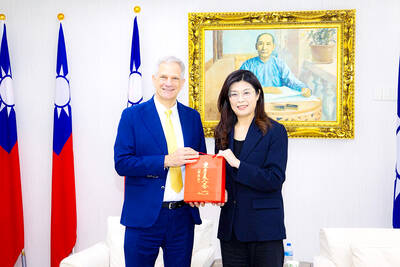The pitch: Eight weeks in Antarctica. Groundbreaking research into the climate before the Ice Age. Glaciers. Volcanoes. Adorable penguins.
The details: Camping on the sea ice in unheated tents, in minus 20oC temperatures. Blinding whiteouts. The bathroom? A toilet seat over a hole in the ice.
Stephen Pekar, a geology professor from Queens College, was selling Shakira Brown, a 29-year-old Harlem middle school science teacher, on his expedition.

PHOTOS: NY TIMES NEWS SERVICE
Her response: I'm in.
Pekar had found just the person for his Antarctica team: a talented, intrepid African-American teacher to be a role model for minority science students.
"I'm tired of having a bunch of white people running around doing science," said Pekar, who is white. "When it comes to Antarctica, it isn't just the landscape that's white."

PHOTOS: NY TIMES NEWS SERVICE
Pekar and other scientists want to get more urban minority students excited about science, pointing to studies that show teenagers across the US lagging in math and science scores behind their peers in other industrialized countries.
"These kids don't have the role models, or the environment, that shows them what the possibilities are," he said. "I want Shakira Brown's students to be able to live this experience through her. I want them to be thinking like scientists - like lovers of life."
The trip is sponsored by the National Science Foundation, which sends about 300 scientists to Antarctica each year. Tom Wagner, director of earth sciences for the program, estimates that perhaps three or four African-Americans have joined that research effort.
Relatively few African-Americans, Hispanics and American Indians work in the earth sciences, Wagner said, adding that the foundation was working to bring greater diversity to the field.
Brown, Pekar and three of his students leave in October. They and 11 other team members will meet at McMurdo Station in Antarctica for survival training, including learning how to build an emergency igloo.
At Promise Academy, the charter school where Brown teaches, the students are bursting with questions. Will their teacher catch her own food? (No - Pekar is bringing a chef.) What if Brown falls through the ice? (Unlikely, Pekar says, though their teacher will learn how to avoid cracks.) Will she see polar bears? (No, bears don't live in Antarctica.)
Will her fiance let her make the trip?
"What do you mean, 'Is he going to let me go?' " Brown has told her students. "Of course he's going to let me go. I'm independent. It's the chance of a lifetime."
Eva Ramos, 13, who is in Brown's eighth-grade class, approves. "Ms Brown is a very smart woman," she said. "The trip is going to be hard. But it's for the good of science."
Pekar's search for a teacher began at Harlem Children's Zone, a nonprofit organization that runs Promise Academy. Brown - who gets her students excited about science by having them look at cells under microscopes, ask lots of questions and dream up their own experiments instead of just memorizing facts for state standardized tests - was at the top of everyone's list as the ideal Antarctica explorer-educator.
Brown makes science both understandable and cool, Eva said. "When I was younger, I hated science," she said. "The teachers talked too much. After they talk a lot, you get bored. Brown gives us examples from real life. When she teaches us something, I learn it in a snap."
Brown plans to teach her students - along with dozens of others through the Urban Science Corps, a NASA-affiliated, nationwide after-school program she is helping to develop - with lessons live from Antarctica, via video conferencing and blogging.
At Promise Academy, the Antarctica studies have already begun. On a recent outing to the American Museum of Natural History, Brown's students got to touch penguin feathers. They were enthralled by Pekar's slides of his last trip to Antarctica.
"I want to get them to visualize it, to envision themselves there," Brown said in a recent interview. "You hear about Antarctica in the fourth grade when they're doing all the continents of the world, but it's not a place you consider tangible. You can picture Virginia: Your grandmother lives in Virginia. But who lives in Antarctica?"
Brown grew up in Irvington, New Jersey, just outside Newark, one of five children raised by a single mother who is a social worker. Sophomore biology at Irvington High School - and an inspiring teacher named Miss Jordan - hooked her on science. She went to Hofstra University intending to become a doctor.
But during a stint as a substitute teacher in a Newark middle school - she was working her way through college - she felt called to teaching, she said.
"I prayed over it, and that's where I was led," she said. "When you pay attention to where you're supposed to be, when you operate inside your gift, it just becomes easy. I found my gift; my gift found me."
"I'm a young African-American teacher who came from a public school education, from an urban environment," she went on. "My mom made less than US$30,000 a year, and she raised me and four brothers. Now I'm in a position to empower all these people to have the same path that I was on."
She tells her students they should not be afraid to go anywhere - to Japan (where she went on a fellowship during college), or Africa, or India, or Antarctica. "They ask me, 'If they send you to the moon, will you go?'" she said. "I say: 'Absolutely. You have to go everywhere. Life is bigger than Harlem.'"

Seven hundred job applications. One interview. Marco Mascaro arrived in Taiwan last year with a PhD in engineering physics and years of experience at a European research center. He thought his Gold Card would guarantee him a foothold in Taiwan’s job market. “It’s marketed as if Taiwan really needs you,” the 33-year-old Italian says. “The reality is that companies here don’t really need us.” The Employment Gold Card was designed to fix Taiwan’s labor shortage by offering foreign professionals a combined resident visa and open work permit valid for three years. But for many, like Mascaro, the welcome mat ends at the door. A

Divadlo feels like your warm neighborhood slice of home — even if you’ve only ever spent a few days in Prague, like myself. A projector is screening retro animations by Czech director Karel Zeman, the shelves are lined with books and vinyl, and the owner will sit with you to share stories over a glass of pear brandy. The food is also fantastic, not just a new cultural experience but filled with nostalgia, recipes from home and laden with soul-warming carbs, perfect as the weather turns chilly. A Prague native, Kaio Picha has been in Taipei for 13 years and

Since Cheng Li-wun (鄭麗文) was elected Chinese Nationalist Party (KMT) chair on Oct. 18, she has become a polarizing figure. Her supporters see her as a firebrand critic of the ruling Democratic Progressive Party (DPP), while others, including some in her own party, have charged that she is Chinese President Xi Jinping’s (習近平) preferred candidate and that her election was possibly supported by the Chinese Communist Party’s (CPP) unit for political warfare and international influence, the “united front.” Indeed, Xi quickly congratulated Cheng upon her election. The 55-year-old former lawmaker and ex-talk show host, who was sworn in on Nov.

Even the most casual followers of Taiwan politics are familiar with the terms pan-blue and pan-green. The terms are used so casually and commonly with the assumption that everyone knows what they mean, that few stop to really question it. The way these terms are used today is far broader and extensive than what they were originally created to represent. Are these still useful shorthand terms, or have people become so obsessed with them that they color perceptions to the point of distortion? LEE TUNG-HUI WAS NO SMURF People often assume that these terms have been around forever, or at least as